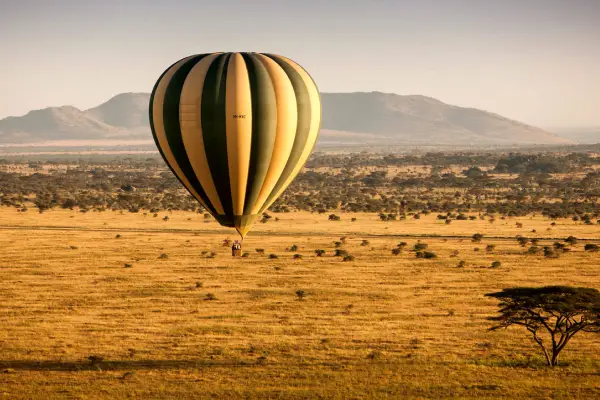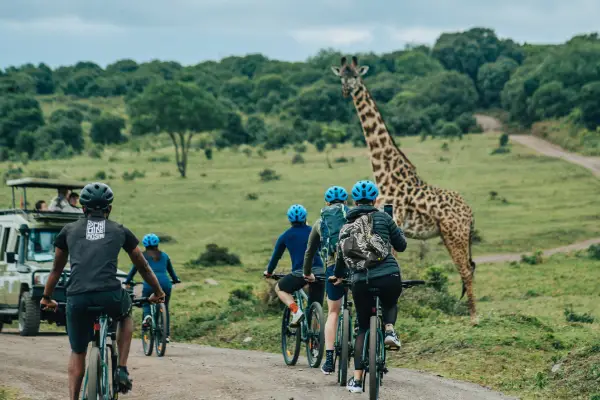100% refundable deposits
100% refundable deposits
Experience the incredible beauty of Africa's wildlife and landscapes with Tanzania's Northern Safaris. With several Tanzania National Parks, each with its own special set of wonders the area is home to some highly acclaimed national parks.
A Safari in Northern Tanzania invites you to explore its diverse array of natural settings:
The vast plains here are the stage for the Great Wildebeest Migration, an impressive sight where millions of animals roam freely. The Serengeti is also home to the largest populations of lions, giraffes, and cheetahs in Africa, spread over an expansive 15,000 km².
Known for its dense elephant population, Tarangire National Park is a scenic park dotted with ancient baobab trees and wide, open landscapes that capture the heart.
This park is famous for its tree-climbing lions, offering a rare glimpse of these majestic creatures lounging in acacia trees. Bird lovers will also enjoy the park, with over 350 bird species identified here.
For those who seek a physical challenge, Mount Kilimanjaro calls. Climbing Africa’s highest peak provides not only breathtaking views but also a sense of achievement as you traverse through varied ecological zones.
This area is known for the Ngorongoro Crater, a vast volcanic caldera that's home to an incredible density of wildlife, including the Big Five. The crater offers a close-up look at a vibrant ecosystem where wildlife thrives in abundance.
The Northern Circuit in Tanzania is a journey into the heart of Africa’s natural beauty. From the Serengeti’s endless plains to Kilimanjaro’s towering peak, our Tanzania Safari Tours are designed to captivate and enchant.
Book your safari today and witness the compelling beauty and vibrant wildlife of Tanzania’s top safari destinations. Let’s make memories filled with excitement and awe in the stunning landscapes of Northern Tanzania.

All itinerary activities with a local, certified guide

We provide Kailas X3 III alpine tents with vestibules

All nutritious meals while on the trek.

To and from the airport and everything in between

All permit fees and taxes

Solo-friendly by nature, join our small groups



 25°C
25°C
 45MM
45MM
January is a lush and vibrant time in the Serengeti, marking the peak of the calving season. The southern plains come alive with newborn wildebeests and zebras, offering a spectacular wildlife experience. The weather is warm with occasional showers, creating a green and flourishing landscape. This period is ideal for observing young animals and their interactions with predators, all while enjoying a relatively quiet park with fewer tourists.
 25°C
25°C
 45MM
45MM
February continues the calving season with a high concentration of newborns across the southern Serengeti. The lush vegetation supports large herds of wildebeest and zebra, and predator activity remains high, making it an exciting time for wildlife viewing. The weather remains warm with occasional rains, and the park is still less crowded, providing excellent opportunities for intimate wildlife experiences.
 25°C
25°C
 45MM
45MM
By March, the calving season begins to wind down, and the herds start moving northward. The landscape remains green and vibrant due to ongoing rains, but the vegetation starts to thicken, which can make wildlife spotting more challenging. However, the park’s reduced number of visitors means a more serene safari experience, and the start of the migration northward offers exciting prospects for observing the moving herds.
 25°C
25°C
 45MM
45MM
April is characterized by heavy rains, making it one of the wettest months in the Serengeti. The landscape transforms into a lush paradise, but the roads can become muddy and challenging to navigate. Wildlife viewing can be more difficult due to dense vegetation and wet conditions, but the park’s reduced tourist numbers offer a quieter experience and a unique opportunity to see the park in its most verdant state.
 25°C
25°C
 45MM
45MM
May continues with the long rains, maintaining the park’s lush, green appearance. The increased vegetation can obscure wildlife, making sightings more difficult. However, this is a less crowded time, providing a peaceful safari experience. As the migration herds start moving north, there are opportunities to witness the beginnings of the migration, offering a quieter but still engaging wildlife experience.
 25°C
25°C
 45MM
45MM
June marks the beginning of the Avg Temperature, with warm, pleasant weather and minimal rainfall. The landscape starts to dry out, and wildlife concentrations increase around water sources, making it easier to spot animals. The Great Migration typically begins its journey northward, and the park’s clearer conditions provide excellent opportunities for viewing river crossings and large gatherings of wildlife.
 25°C
25°C
 45MM
45MM
July is one of the prime months to visit the Serengeti, as the Avg Temperature is in full swing. The Great Migration reaches the northern Serengeti, where dramatic river crossings occur. The dry conditions ensure clear visibility and easier access to wildlife, though it is also the height of the tourist season. The warm weather and high concentrations of wildlife make for an unforgettable safari experience.
 25°C
25°C
 45MM
45MM
August continues with excellent conditions for wildlife viewing as the Great Migration remains in the northern Serengeti. The dry, warm weather makes for clear skies and easy access to the park’s various wildlife hotspots. This is an ideal time for witnessing the spectacular river crossings and observing large predator populations, though it can be quite busy with tourists.
 25°C
25°C
 45MM
45MM
In September, the Avg Temperature persists, providing excellent conditions for game viewing. The Great Migration herds are still moving south, and wildlife remains concentrated around water sources. The dry weather and open landscapes make it easier to spot animals, and the crowds start to thin out slightly, offering a more relaxed safari experience compared to peak months.
 25°C
25°C
 45MM
45MM
October marks the transition from the Avg Temperature to the short rains. The Great Migration herds continue their southward movement, and wildlife is concentrated around remaining waterholes. The landscape begins to show signs of green as the rains approach, and the park sees fewer tourists, making for a more tranquil and enjoyable safari experience.
 25°C
25°C
 45MM
45MM
November brings the start of the short rains, with occasional showers and a rapidly greening landscape. The migration herds continue moving south, and the park’s transformation into a lush environment offers beautiful scenery. The reduced number of visitors and vibrant landscape provide a serene and picturesque safari experience.
 25°C
25°C
 45MM
45MM
December features ongoing short rains, which further enhance the park’s lush and green appearance. The calving season begins in the southern Serengeti, with herds returning and newborn animals becoming more common. The warm weather and vibrant environment, combined with fewer tourists, create an ideal setting for observing new life and enjoying a peaceful safari.

Talk to Us. Our Experts are just a Click Away!












I hiked Killimanjaro with a local company called Ascend Tanzania. I could not recommend a company more highly.






I had no idea what I was signing up for when I decided, without any prior experience of a trek of this calibre






Climbing Kilimanjaro was one of my greatest mountain experience so far.






Ascend is a top-notch Kilimanjaro tour guide company that I would highly recommend






Ascend tanzania is an affordable company run by the most efficient local people!
"Excellent Company To Climb With"
I booked my Kilimanjaro climb (6 Day Machame route) with Ascend Tanzania because I was travelling solo and on a budget
Read Reviews